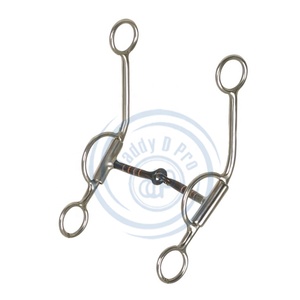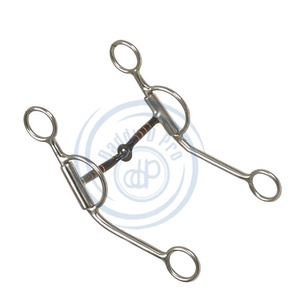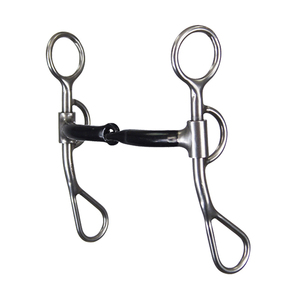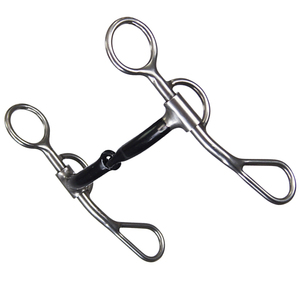
All categories
Featured selections
Trade Assurance
Buyer Central
Help Center
Get the app
Become a supplier

(813 products available)





































The Argentine snaffle bit is a popular bit with multiple uses in the equestrian world. It is a mild bit used for control and guidance. The bit has different types that include:
Bits are used in different scenarios, such as in training, competition, and even pleasure riding. They provide communication and control between the rider and the horse. Here are some usage scenarios of the Argentine snaffle bits:
Daily Training
Argentine snaffle bits are used daily during training sessions. They help the horses learn new skills and improve existing ones. The bits provide the necessary guidance and support for the horse's learning. They also help reinforce the various patterns and commands.
Flatwork
These bits are used in flatwork sessions, which focus on developing a horse's basic skills. They are important in achieving flexibility, responsiveness, and control. The bit's unique design enables riders to use subtle cues. This leads to increased cooperation and understanding between them and the horse.
Jumping
The Argentine snaffle bits are used for show jumping and other jumping disciplines. They help in maintaining the horse's focus and control, especially at high speeds and over complex jumps. The bit allows riders to make quick adjustments, ensuring the horse stays balanced and confident.
Dressage
These bits can be used during dressage competitions and training. They help in achieving precision and finesse in various dressage movements and patterns. The bit provides the necessary softness and comfort, allowing the horse to perform with grace and ease while maintaining control.
Riding in Different Terrains
Argentine snaffle bits can be used for horseback riding in various terrains, such as in the fields or in the mountains. They help in navigating through different terrains and obstacles. The bit provides extra control and guidance, especially when riding downhill slopes or going through tight spaces.
Horses with Sensitivity Issues
The Argentine bits are handy for horses that are sensitive to bit pressure. This is because they evenly distribute pressure on the horse’s mouth. They provide a comfortable and gentle feel, making the horse more willing to respond to the rider's cues.
Choosing the right argentine snaffle bit is crucial for the comfort of the horse and the effectiveness of communication between the rider and the horse. Here are several factors that should be considered.
Material
Each material that is used to make argentine snaffle bits has a unique experience that it offers to the horse. Stainless steel is strong and durable, while sweet iron is more sensitive to a horse's saliva. Consider how each material will affect the comfort of the horse and the longevity of the bit.
Size
Getting the right size for the snaffle bit is very important for the comfort of the horse. If the bit is too small or too big, it will cause discomfort to the horse. Always ensure that the bit is the right size and use measuring tools to measure it if necessary.
Type of Snaffle Bit
There are different types of argentine snaffle bits, and each has its own use. For instance, double jointed bits are suitable for horses with sensitive mouths, while single jointed bits are more common and offer a more direct communication. Choose the type of snaffle that will be more suitable for the horse's mouth structure and the riding style.
Thickness
The thickness of the argentine snaffle bit affects the pressure it exerts on the horse's mouth. Thinner bits apply more pressure, while thicker bits are more forgiving. Riders should consider the sensitivity of their horse and the level of communication they want to have when choosing the thickness of a snaffle bit.
Ring Size
The size of the ring on the argentine snaffle bit affects the leverage and pressure it exerts. Larger rings provide more pressure and control, while smaller rings are lighter and more responsive. Riders should consider their riding style and the level of control they need when choosing the size of the ring.
Argentine snaffle bits come in various designs and have different features that affect their function. Here are some of them.
Single Jointed
This design has a single joint in the middle of the mouthpiece that creates a pivot point when the reins are pulled. This movement applies pressure on the horse's lips and tongue. The pressure becomes more intense when equestrians try to get the Argentine snaffle to swing. The single-jointed Argentine snaffle bit is more rigid and, therefore, more stable. It offers better control and steering. However, it can cause discomfort to some horses since it exerts more pressure on the horse's tongue.
Double Jointed
The mouthpiece of a double-jointed Argentine snaffle bit consists of two curved pieces of metal joined by a smaller joint. When the reins are pulled, the two mouthpiece bits apply pressure on the horse's tongue and lips. The pressure becomes more intense when the bit is made to swing. The double-jointed Argentine snaffle bit is more comfortable and offers a precise communication level between the horse and rider. However, it is less stable and has a delayed response.
Eggbutt
This design features a rounded outer ring that reduces the bit's mouthpiece pinching effect on the horse's lips. The bit distributes pressure evenly on the horse's mouth, giving a smoother and more comfortable experience. The bit is less mobile, and its joints don't influence the horse's steering and control much. The bit is ideal for horses that are sensitive to bit pressure and discomfort.
D-Ring
The D-ring Argentine snaffle bit has a bit of added movement and flexibility. This design allows the rider to have a more controlled steering and guidance. The bit applies pressure to the horse's tongue and lips, allowing for a more responsive steering. The D-ring bits are suitable for riders who enjoy some level of refinement and gentleness in their steering.
Loose Ring
This design has a circular ring that is free to move and offers more flexibility. The loose ring Argentine snaffle bit is less stable, providing less control and steering. This design is ideal for horses that are not very sensitive to bit pressure.
Q1. What is the difference between a snaffle bit and a curb bit?
A1. The main difference between a snaffle bit and a curb bit lies in their action and the type of leverage they provide. A snaffle bit, like the Argentine snaffle bit, has jointed rings that create a direct pressure on the horse's mouth, nose, and poll without any curb leverage. It is commonly used for English riding and jumping. On the other hand, a curb bit has shanks that amplify the rider's signals through leverage, providing a more pronounced effect on the horse's mouth and poll while applying pressure to the chin and neck. Curb bits are usually used for Western riding and dressage when more control and subtlety are needed. The Argentine snaffle bit combines elements of both, offering the gentleness of a snaffle with the curb's increased control and guidance.
Q2. Is an Argentine snaffle bit harsh?
A2. No. The Argentine snaffle bit is not severe but rather a mild bit. The gentleness of a bit is subjective and depends on some factors, like the mouthpiece style, materials used, and overall design. Generally, a bit that applies little pressure on the tongue, lips, and bars of a horse's mouth is considered mild. Similarly, a bit that doesn't exert much leverage on the poll and reins is termed mild. The severity of a bit is also affected by its size and the height at which it sits in a horse's mouth. A smaller bit sits higher in a horse's mouth and applies more pressure than a larger bit, which sits lower. Ultimately, the severity of a bit depends on how its design affects the level of pressure it applies to a horse's mouth and the amount of leverage it exerts.
Q3. What is the purpose of an Argentine snaffle bit?
A3. Argentine bits are designed for more than just controlling and steering a horse. They serve various functions, including assisting with collection, encouraging a horse to lower its head and bring its neck closer to the rider, and providing a softer, more nuanced form of communication between the rider and the horse.